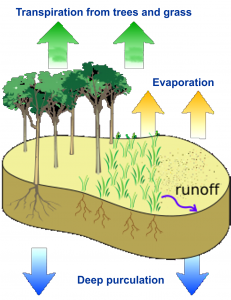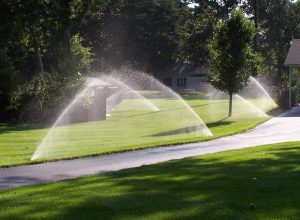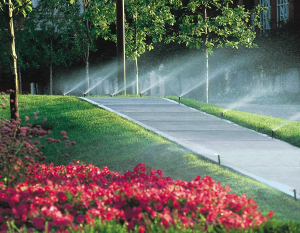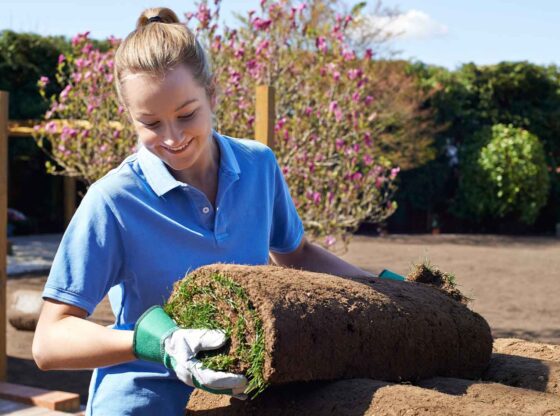To begin, I am fully aware that certain parts of our nation have a fresh water supply problem. When nature throws a drought period into an already tight water supply things get ugly. It just so happens where water is in short supply we also have large growing populations. This is a conundrum of the supply and demand equation being out of whack.
Further, I believe our industry is obligated to conserve resources. As a boy, I was taught in church that we are to be wise stewards of God’s creation. Being frugal and protective with natural resources is an old and wise precept. I believe a sign of true wisdom is being able to find balance in the world. Balance is what we need to handle our water dilemmas. At one end of the scale are the out-of-hand-water-wasters, at the other end are the totalitarian no-tolerance regulators. In the middle is the real answer.
The Water Cycle
 I challenge the “water waste” definition. Is water really “wasted” by the Green Industry? Water moves through the water cycle. Green Industry use may move a quantity of water through the cycle a little faster, but is it wasted? I say the water is not wasted, it is still water and still in the water cycle.
I challenge the “water waste” definition. Is water really “wasted” by the Green Industry? Water moves through the water cycle. Green Industry use may move a quantity of water through the cycle a little faster, but is it wasted? I say the water is not wasted, it is still water and still in the water cycle.
Water used by the Green industry will be back after it moves through the cycle. When it comes back is the issue. What the anti-water wasters are really concerned about is having enough fresh water today.
The real answer is living in balance with the water cycle. In other words, making the human water demand match nature’s ability to supply it. Such constraints held back human population growth for most of our history. Only when we developed technology could we push back Nature.
So, in southern California where a large growing population has an increasing water demand how do you reduce demand? The most simplistic answer is to reduce the human population. OK, how do you reduce population? Realistically, reducing population can only be accomplished when living in southern California is no longer desirable. Then we have a severe economic issue to contend with! Which leads me to another rule of life.
Law of Unintended Consequences
 Whenever the natural order is monkeyed with by humans we find bad things happen that nobody thought about. The natural order of things is a massive, highly interconnected, intertwined system that no human can understand. It is pure hubris whenever anyone says they have a simple answer to a nagging problem regarding natural order. Every action trips equally powerful reactions.
Whenever the natural order is monkeyed with by humans we find bad things happen that nobody thought about. The natural order of things is a massive, highly interconnected, intertwined system that no human can understand. It is pure hubris whenever anyone says they have a simple answer to a nagging problem regarding natural order. Every action trips equally powerful reactions.
What is the natural order? Every human will seek to fulfill their own personal desires. They will work in their own best interest. Every living creature does the same thing. Combine those trillions and trillions of micro actions together and you have a self leveling natural order. Named by Adam Smith, the Invisible Hand.
Every time someone jabs the natural order, ripples are sent through the system. Since there are trillions and trillions of micro actions happening at any moment, the result cannot ever be discerned by the people initiating the jab. We see such bad results caused by governments throughout history. Governments love to jab the system because they believe they can control it.
No human can ever control natural order. Smart humans find ways to work within it. Fighting nature requires a continual massive amount of dedication and energy. Once dedication or energy wanes the natural order settles in again.
Point in case; as wondrous and eternal as our great cities appear, once humans are gone from Earth those cities will be completely reclaimed by nature within a few lifetimes. The buried remains of large Mayan cities are still being found in Central America.
California Experience
Arid States have been paying people to get rid of lawns with the idea it will save water. An article from 2016, “Is Getting Rid of Turf Really the Answer?” suggests this claim may not be true. California’s Governor, Brown pushed for the 2015 Turf Replacement Initiative. A budget of $24 million to pay people $2 per square foot was given to remove turf grass and replace it with stone, native plants, or artificial turf. The goal was to remove 20% of the State’s turf grass.
After a year in just one district, the Department of Water in Los Angeles paid out more than $350 million. Another governmental unintended consequence; over budget again. Now there’s a backlash. People learned their property now consists of dead plants, excessive weed growth, and ugly rock-filled landscapes. Contractors are being called to come rip it all out and replant a lawn. Its being called “Rebate Remorse.”
Suffocated Soils
Another issue is suffocated soils. Once the turf grass is removed they laid landscape fabric and poured mulch or stone. The soil, now deprived of water and oxygen, suffered. Earthworms, microbes, and all the good stuff that makes soil rich are gone. Another casualty are trees. With the grass stripped away, hotter temperatures, suffocated soils, and lack of water has caused many trees to die. Add to that a rapidly growing concern about run-off.
Sandra Giarde with the CLCA said, “With the wholesale movement to replace turf that took place last year, you would have thought someone would say, “wait a sec- we better do an environmental study first”.” Neither was there an analysis of the return on investment.
To be clear, most of California really does have a serious water supply problem. Balance would dictate that the residents are going to learn living in a desert means your landscape cannot look like something in Ohio. Balance would say work with nature, emulate what she does in that region. A golf course in southern California should look like southern California, not Augusta, Georgia.
Perception and Scapegoats
The California experiment happened because of a general perception that landscapes, especially turfgrass, are major water wasters. The reality is turf grass dominates semi-arid regions. It is a very good water user and many varieties do fine with but a fraction of the water we apply.
The California Department of Water web site states, “Outdoor landscaping is the single largest use of water in the typical California home. So reducing or eliminating how much grass we have in our landscapes can have a significant impact on the state’s water use.” True statement? I not only challenge the premise, but the math. However, if a perception is allowed to exist it will cause actions.
Toro’s Mike Baron said, “If you look at all the water that’s in our infrastructure, 50% goes to environmental purposes, 40% goes to agriculture, and only 10% is devoted to urban purposes. In California, the estimate is that half of that 10% goes to outdoor landscapes; leaving only 5%. So, the question is, do we really want get rid of every single lawn, just to save 2.5% of the total water supply?”
Balance is the Answer
 The Green Industry is small compared to many others. We are not understood by most folks; and we are a collection of many small businesses that is not well organized. It’s easy for the general population to lay blame on the Green Industry. The Green Industry must first get better at minimizing water use and then fight back against unsubstantiated perceptions. The Irrigation Association is leading the way for us, support them.
The Green Industry is small compared to many others. We are not understood by most folks; and we are a collection of many small businesses that is not well organized. It’s easy for the general population to lay blame on the Green Industry. The Green Industry must first get better at minimizing water use and then fight back against unsubstantiated perceptions. The Irrigation Association is leading the way for us, support them.
The IA’s work with the EPA Water Sense program has made the irrigation industry a participant in a workable program instead of a casualty of government regulatory overreach. More similar actions must take place. A University of California study showed that 2/3rds of water reduction realized by cutting back turf grass actually resulted from the improvement to the irrigation system. Fixing up and updating the irrigation saves way more water than a complete elimination of turf grass!
For California, the answer will likely be reducing the amount (not elimination) of turf areas in a landscape. This will improve irrigation systems and practices, and living with dormant turf during dry spells. Not all that hard for most to accept. We don’t have to give up our lifestyle, it just needs tweaking where there’s an issue. It is about finding balance. We know how and we have data to prove our case. Next time you are challenged about wasting water, be ready to answer back.
By Scott Knowles, President of Wolf Creek Co.












